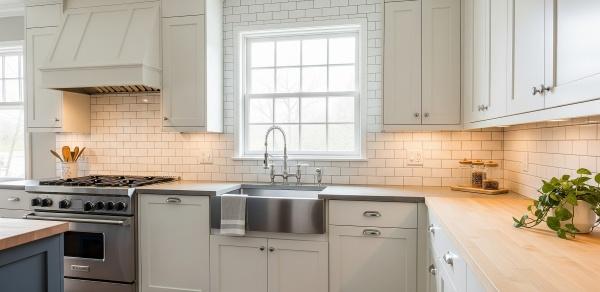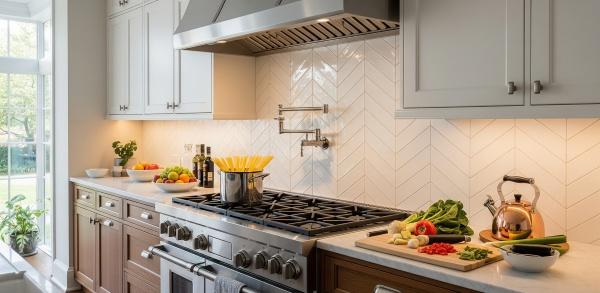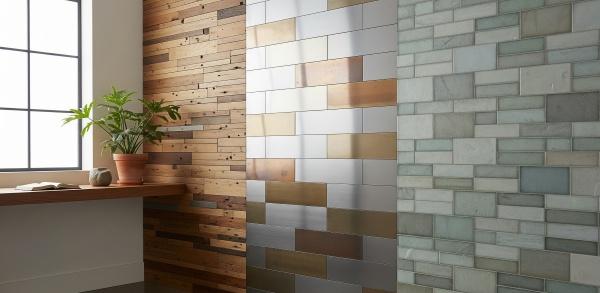Subway tile is a rectangular ceramic tile, typically 3x6 inches, installed in a 50% offset pattern that originated in New York's first subway station in 1904. This classic design element has maintained popularity for over 120 years due to its durability, easy maintenance, and timeless aesthetic appeal.
What You'll Learn in This Complete Guide:
Definition & Specifications: Subway tiles are rectangular tiles with 1:2 proportions (most commonly 3x6 inches) made from ceramic, porcelain, or glass materials.
Historical Significance: Originally chosen for NYC subway stations because of their hygienic properties, stain resistance, and bright reflective surfaces that enhanced underground safety.
Installation Patterns: Traditional 50% offset (brick pattern), plus modern variations including herringbone, grid patterns, and one-third offset arrangements.
Cost & Materials: Affordable option starting with basic white ceramic, with premium choices including marble-look, textured, and colored varieties.
Popular Applications: Kitchen backsplashes, bathroom showers, feature walls, and fireplace surrounds.
Design Versatility: Available in multiple sizes (2x4, 4x8, 6x12 inches), colors beyond traditional white, and various textures including beveled edges.
Whether you're planning a kitchen renovation, bathroom remodel, or looking to add classic elegance to any space, this comprehensive guide covers everything from basic installation techniques to creative pattern innovations that will help you achieve professional results.
Ready to transform your space with one of design's most enduring elements? Let's explore why subway tile remains the go-to choice for homeowners and designers worldwide.
Understanding Subway Tile Fundamentals
What Defines Subway Tile?
Subway tile consists of rectangular ceramic tiles, typically measuring 3 x 6 inches, installed horizontally with a 50% staggered pattern. This classic material combines exceptional durability with a style that transcends trends.
The Historic Connection
Discover why these tiles earned their distinctive name: they debuted in New York's inaugural subway station in 1904. Designers needed a surface solution that delivered both low-maintenance performance and brightness for underground transportation.
The Victorian era's emphasis on cleanliness made ceramic tile the perfect choice. Its easy-to-clean, stain-resistant, and bacteria-fighting properties addressed health concerns. The white, glossy finish created highly reflective surfaces that enhanced safety and cleanliness for passengers navigating the underground system.
Exploring Subway Tile's Enduring Appeal
Current Market Position
Following its 1904 debut, subway tile expanded to transportation centers worldwide. Its hygienic appearance and health advantages led to adoption in kitchens, bathrooms, and anywhere cleanliness mattered.
Today's market shows continued growth in subway tile popularity.
Trend vs. Timeless Design
While some question whether subway tile represents a passing fad, its 100+ year history proves otherwise. This longevity signals lasting appeal among homeowners and business owners.
The secret lies in subway tile's inherent timeless quality. Simple white rectangular tiles arranged in straightforward patterns create designs that are both striking and achievable.

Essential Subway Tile Knowledge
Pattern Specifications
Traditional installation requires a 50% offset pattern, where each tile's center aligns with the edges of tiles above and below it. Contemporary approaches often modify this pattern or abandon it entirely. Alternative arrangements include one-third offset and one-fourth offset patterns.
Size Standards and Variations
The classic 3 x 6 inch dimension remains most popular. However, any rectangular tile maintaining 1-to-2 proportions qualifies as subway tile. Common alternatives include 2 x 4, 4 x 8, and 6 x 12 inch sizes. For those interested in exploring different dimensions, you can shop by size to find the perfect proportions for your project.
Material Options
The original subway tile used ceramic material. Today's options include ceramic, porcelain, and glass tiles – all chosen for identical reasons: minimal maintenance requirements and outstanding style potential. When selecting materials, consider browsing products we carry to understand the full range of available options.
Cost Considerations
Subway tile offers affordable options, particularly when selecting traditional white designs.
Installation and Maintenance Mastery
Installation Preparation
Research your specific application requirements thoroughly, whether installing backsplashes or shower applications. Study details like corner installation techniques or shower niche tiling methods. Consider hiring qualified tile installers if you lack necessary skills or tools. For comprehensive installation guidance, refer to This Old House's tile installation guide and Erin's installation tutorial.
Layout Techniques
Execute traditional subway tile designs using 50% offset patterns. Each tile's middle point should align with adjacent tiles' edges above and below. Use the tile's short side to locate the long side's center point. Complete dry layouts before installation to identify required cuts. For detailed installation basics, Rubi's technical guide provides professional insights.
Cutting Methods
Tile cutting may be necessary to accommodate outlets and space dimensions. Some cuts work with score-and-snap methods using snap cutters, while others require wet saws. Porcelain and glass materials typically demand wet saw cutting. Hire qualified installers if you lack proper tools or safety skills. Marazzi's installation resources offer additional cutting technique guidance.
Timeline Expectations
Installation duration depends on area size, layout complexity, and installer experience. Traditional applications install relatively quickly, especially smaller areas like backsplashes.
Substrate Requirements
Install subway tile over drywall in low-moisture areas. High-moisture locations (like shower walls) benefit from cement board backing for enhanced long-term durability.
Painting Considerations
Avoid painting ceramic tiles except for small DIY projects. Paint application may compromise stain and scratch resistance, with designs potentially failing over time. Choose tiles in desired colors or patterns instead.
Cleaning Procedures
Clean subway tiles like any ceramic tile using simple water wiping. For comprehensive cleaning guidance, consult GSA's ceramic tile maintenance guidelines and Daltile's porcelain care instructions.
Grout Application and Selection
Follow manufacturer instructions for mixing and applying your chosen grout.
Grout Color Coordination
White subway tile pairs commonly with white, gray, or black grout. However, any tile color works with any grout color. Consider whether you want to emphasize or de-emphasize the layout pattern. High-contrast grout highlights patterns, while matching grout creates seamless appearances. Colorful grout adds unique character to white tiles. Note: High-contrast grout may reveal imperfections and tile size variations more easily.
Grout Joint Sizing
Standard 3 x 6 inch subway tiles typically use 1/16 inch grout joints, though 1/8 inch joints are also common.
Creative Pattern Innovations
Now that you understand traditional characteristics, explore boundary-pushing modern applications that showcase unique design approaches.
One-Third Offset Pattern
Create subtle variation from traditional 50% offset using one-third offset arrangements.
One-Fourth Offset Pattern
Achieve stair-climbing visual effects by staggering tiles 25%.
Grid Patterns
Horizontal Grid: Remove offsets completely for standard horizontal grid layouts.
Vertical Grid: Rotate tiles sideways for vertically stacked patterns. Vertical layouts elongate backsplashes or walls while drawing eyes upward. Rotate traditional layouts 45 degrees for diagonal patterns.
Herringbone Applications
Herringbone subway tile installation adds movement to any application and works at various angles for different effects.
Herringbone Installation: This pattern requires more complexity than traditional offset patterns due to diagonal cuts around outlets and space edges. Make precise measurements and practice layouts before beginning.
Straight Herringbone: Create 90-degree herringbone patterns by placing one tile vertically and another perpendicular to it, then repeating the sequence.
Diagonal Herringbone: Horizontal herringbone "<" or ">" patterns generate horizontal rather than vertical movement.
Advanced Creative Applications
Whether maintaining traditional layouts or experimenting with alternatives, numerous options exist for distinctive subway tile designs. When exploring creative possibilities, consider browsing tile options by style to discover unique design inspirations.
Color Transformations
Challenge the white-only assumption by incorporating colorful tiles for fun, modern updates. Consider neutral beige options for brick effects, or explore any color preference. The Odyssey collection in matte and glossy finishes offers excellent color variety for creative applications.
Multi-Color Integration
Combine multiple colors by sprinkling different colored tiles randomly throughout designs for unique appearances.
Pattern and Natural Aesthetics
Expand beyond monochromatic approaches with natural looks (marble, granite, wood) and patterns (graphic designs, florals, Art Deco prints). The Mozart marble-look collection provides subtle marble veining on white backsplashes while maintaining traditional appearance with luxurious elements.
Miniature Approach: Use small tiles for subway tile mosaics, ideal for smaller applications like backsplashes.
Oversized Options: Choose larger-than-average tiles for spacious areas like entire showers, though these aren't technically subway tiles.
Combined Sizing: Mix different sizes for unique subway tile looks.
Dimensional Changes
Move beyond standard 3 x 6 inch dimensions. Thinner, elongated sizes create running bond pattern appearances (50% offset patterns). Consider the Mozart elongated hexagon tiles for a sophisticated twist on traditional subway proportions.
Textural Elements
Select textured surface tiles for designs that invite both visual admiration and tactile exploration.
Beveled Designs
Create three-dimensional effects with beveled subway tiles featuring sloped edges and protruding surfaces.
Accent Integration
Enhance uniqueness through tile accents: borders at top or bottom edges, focal points, or accent tiles between subway tiles. The Mozart bullnose collection provides perfect finishing touches for professional-looking installations.
Grout Color Innovation
Move beyond standard white, gray, or black grout by choosing colorful options for distinctive designs. White subway tile with colored grout emphasizes layout patterns, while matching grout maintains seamless aesthetics.
Staggered Transitions
Implement trending staggered tile transitions that end along natural tile shapes rather than straight cut edges. Subway tile excels for staggered transitions, highlighting creative layout possibilities.
Use staggered transitions to move between different subway tile colors, shapes, or materials entirely.
Strategic Application Areas
Subway tiles typically function as wall tiles in various applications:
Backsplash Installation
Backsplashes represent the most common subway tile application today. Traditional white designs complement virtually any kitchen or bathroom, with customization options for specific spaces.
Ceramic tile's water and stain resistance protects walls behind counters while ensuring lasting beauty.
Feature Wall Creation
Following original New York subway station examples, entire walls can showcase subway tiles effectively. Consider rustic gray designs for living room applications. The Odyssey hexagon collection offers geometric variations that create stunning feature walls.
Fireplace Surround Enhancement
Fireplace surrounds benefit from subway tile installation, such as weathered reddish-brown options. Ceramic tile's flame-resistance eliminates heat or flame damage concerns.
Shower Applications
Subway tiles work excellently in showers, with traditional white designs particularly favored for Victorian-inspired aesthetics. Victorian-era all-white bathrooms used plain tiles for less visible home areas.
Today's designs proudly display white tile rather than hiding it.
Mastering the Timeless Choice
Understanding subway tile's universal appeal, century-plus endurance, and permanent design status reveals why this option remains beloved. You now possess the knowledge and tools to design perfect subway tile solutions for your home. For the complete selection of quality products, visit our comprehensive catalog.
Continue your inspiration journey by exploring design galleries and creative subway tile Pinterest boards. Consider complementary stylish kitchen floor tile designs to complete your space transformation. For local sourcing and expert guidance, explore local shopping options or contact professionals who can help bring your vision to life. Visit our main showroom for hands-on tile selection assistance.
Conclusion
Subway tile stands as one of interior design's most enduring and versatile choices, proving that true style transcends fleeting trends. From its practical origins in New York's 1904 subway system to today's diverse applications in modern homes, this classic 3x6 inch rectangular tile continues to deliver the perfect balance of functionality, beauty, and timeless appeal.
Whether you're drawn to the traditional white ceramic tiles with their clean, hygienic appearance, or you're ready to explore creative variations with bold colors, unique patterns, and textural elements, subway tile offers unlimited possibilities for personal expression. Its affordability makes it accessible to any budget, while its durability ensures your investment will last for decades.
The key to successful subway tile implementation lies in understanding both its classic foundations and modern innovations. Master the traditional 50% offset pattern, then feel confident experimenting with herringbone layouts, grid patterns, or creative color combinations. Remember that subway tile's greatest strength is its adaptability-it works beautifully in minimalist designs and equally well in bold, statement-making applications.
As you embark on your subway tile project, whether it's a simple kitchen backsplash or an entire bathroom renovation, you're joining over 120 years of homeowners who have discovered the lasting satisfaction of this remarkable design element. Subway tile isn't just a design choice-it's an investment in timeless style that will continue to look fresh and relevant for generations to come. The professional bullnose trim options ensure your installation has the finishing touches that elevate the overall design. For additional tile maintenance resources, consult Marazzi's care guidelines and professional maintenance advice.
Would you like more information
about a product?
Frequently Asked Questions
What makes a tile qualify as "subway tile"?
Subway tile is defined by its rectangular shape with 1:2 proportions, traditionally measuring 3x6 inches. The tile must be installed horizontally with a 50% offset pattern (also called brick pattern) where each tile's center aligns with the edges of the tiles above and below it. While the classic size is 3x6 inches, other proportional sizes like 2x4, 4x8, and 6x12 inches also qualify as subway tile as long as they maintain the 1:2 ratio.
Is subway tile just a trend, or will it remain stylish long-term?
Subway tile is definitively not a trend-it's a timeless design element with over 120 years of proven staying power. Since its debut in 1904, subway tile has consistently remained popular across different design eras because of its simple, clean aesthetic that complements rather than competes with other design elements. Its longevity in both residential and commercial applications demonstrates that subway tile transcends temporary design fads.
Can I install subway tile myself, or should I hire a professional?
DIY installation is possible for those with basic tiling skills and proper tools, especially for simple applications like kitchen backsplashes. However, professional installation is recommended for complex areas like showers, spaces requiring extensive cutting around outlets, or when working with expensive materials like natural stone or glass tiles. Key factors to consider include your comfort level with wet saws for cutting, understanding of waterproofing requirements for wet areas, and ability to achieve straight, even layouts. If you're unsure, start with a small, low-risk area to test your skills. For comprehensive guidance, refer to Flooring Inc's step-by-step guide.
What's the difference between ceramic, porcelain, and glass subway tiles?
All three materials offer the classic subway tile look but with different characteristics. Ceramic subway tiles are the most affordable and traditional option, made from clay and fired at lower temperatures. They're perfect for walls and low-moisture areas. Porcelain tiles are denser and more water-resistant than ceramic, making them suitable for high-moisture applications like showers. They're also more durable and stain-resistant. Glass subway tiles offer a luxurious appearance with superior stain resistance and easy cleaning, plus they reflect light beautifully. However, glass tiles are more expensive and require special cutting tools and installation techniques. To explore various material options, browse tile types to understand the full spectrum available.
How do I clean and maintain subway tile?
Subway tile maintenance is refreshingly simple, which is one reason for its enduring popularity. For regular cleaning, simply wipe ceramic and porcelain tiles with water or a mild soap solution. Avoid abrasive cleaners that could scratch the surface. The grout lines require more attention-use a grout cleaner and soft brush for deep cleaning, and consider sealing grout annually in high-moisture areas. Glass subway tiles can be cleaned with standard glass cleaners for a streak-free shine. Never use harsh chemicals or abrasive materials that could damage the tile surface or grout. For detailed maintenance schedules, refer to Bob's tile care guide and professional resources from Nova Tile and Stone.

